
Kalmia latifolia, the mountain laurel, calico-bush, or spoonwood, is a species of flowering plant in the heath family Ericaceae, that is native to the eastern United States. Its range stretches from southern Maine south to northern Florida, and west to Indiana and Louisiana. Mountain laurel is the state flower of Connecticut and Pennsylvania. It is the namesake of Laurel County in Kentucky, the city of Laurel, Mississippi, and the Laurel Highlands in southwestern Pennsylvania.
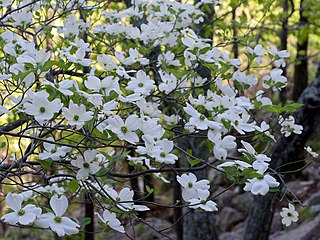
Cornus florida, the flowering dogwood, is a species of flowering tree in the family Cornaceae native to eastern North America and northern Mexico. An endemic population once spanned from southernmost coastal Maine south to northern Florida and west to the Mississippi River. The tree is commonly planted as an ornamental in residential and public areas because of its showy bracts and interesting bark structure.

Ptelea trifoliata, commonly known as common hoptree, wafer ash, stinking ash, and skunk bush, is a species of flowering plant in the citrus family (Rutaceae). It is native to North America, where it is found in Canada, Mexico, and the United States. It is a deciduous shrub or tree, with alternate, trifoliate leaves.

Rosa rugosa is a species of rose native to eastern Asia, in northeastern China, Japan, Korea and southeastern Siberia, where it grows on beach coasts, often on sand dunes. It should not be confused with Rosa multiflora, which is also known as "Japanese rose". The Latin word "rugosa" means "wrinkled", referring to the wrinkled leaves.

Magnolia grandiflora, commonly known as the southern magnolia or bull bay, is a tree of the family Magnoliaceae native to the southeastern United States, from Virginia to central Florida, and west to East Texas. Reaching 27.5 m (90 ft) in height, it is a large, striking evergreen tree, with large dark green leaves up to 20 cm long and 12 cm wide, and large, white, fragrant flowers up to 30 cm (12 in) in diameter.

Stachys is one of the largest genera in the flowering plant family Lamiaceae. Estimates of the number of species in the genus vary from about 300, to about 450. The type species for the genus is Stachys sylvatica. Stachys is in the subfamily Lamioideae. Generic limits and relationships in this subfamily are poorly known.
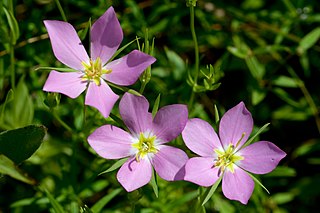
Sabatia campestris is a species of Sabatia, native to the south-central United States, from Texas east to Mississippi and north to Iowa and Illinois. It is also locally naturalized in New England.

Prunus maritima, the beach plum, is a species of plum native to the East Coast of the United States.
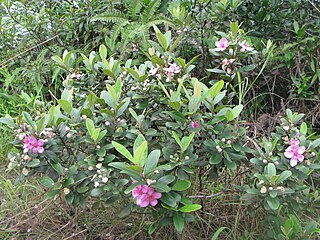
Rhodomyrtus tomentosa also known as rose myrtle, is a flowering plant in the family Myrtaceae, native to southern and southeastern Asia, from India, east to southern China, Hong Kong, Taiwan and the Philippines, and south to Malaysia and Sulawesi. It grows in coasts, natural forest, riparian zones, wetlands, moist and wet forests, bog margins, from sea level up to 2400 m elevation.
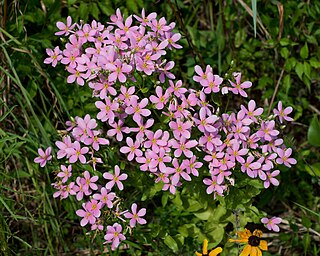
Sabatia, the rose gentians, is a genus of about 20 species of flowering plants in the family Gentianaceae, native to eastern and central North America, Central America, and the Caribbean.

Frankenia pauciflora, the common sea-heath or southern sea-heath, is an evergreen shrub native to southern Australia. It is part of the Frankenia genus of the Frankeniaceae family.

Sabatia kennedyana is a species of flowering plant in the gentian family known by the common name Plymouth rose gentian. It is native to eastern North America. It has a disjunct distribution, occurring in Nova Scotia, Massachusetts, Rhode Island, Virginia, North Carolina, and South Carolina.

Muhlenbergia capillaris, commonly known as the hairawn muhly, is a perennial sedge-like plant that grows to be about 30–90 cm (0.98–2.95 ft) tall and 60–90 cm (2.0–3.0 ft) wide. The plant includes a double layer; green, leaf-like structures surround the understory, and purple-pink flowers outgrow them from the bottom up. The plant is a warm-season grass, meaning that leaves begin growth in the summer. During the summer, the leaves stay green, but they morph during the fall to produce a more copper color. The seasonal changes also include the flowers, as they grow out during the fall and stay healthy till the end of autumn. The muhly grows along the border of roads and on plain prairies. The grass clumps into herds, causing bush-like establishments in the area the hairawn muhly inhabits. The flowers are very feathery and add a cloudlike appearance to the top of the grass. It is native to eastern North America and can be used for a multitude of purposes, including ornamental gardening and farming. It was voted 2012 plant of the year by the Garden Club of America.

Hasteola suaveolens, known by the common names false Indian plantain and sweet scented Indian plantain, is a perennial forb native to the northeastern and north-central United States. It is found from Massachusetts south to Virginia and North Carolina, and west as far as Minnesota and Minnesota and Missouri.

Sagittaria teres, the quill-leaved arrowhead or slender arrowhead, is an aquatic plant species of arrowhead native to the northeastern United States: Rhode Island, Massachusetts, New Hampshire, New York and New Jersey.
Sagittaria filiformis, the threadleaf arrowhead, is an aquatic plant species native to the eastern United States, from Maine south to Florida and Alabama. it occurs in flowing streams in the northern part of its range, but more stagnant waters such as marshes and swamps in the South.
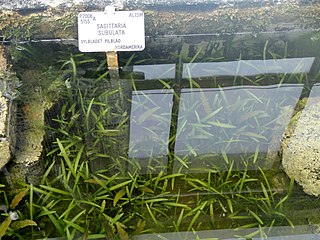
Sagittaria subulata, the awl-leaf arrowhead, narrow-leaved arrowhead or dwarf sagittaria, is an aquatic plant species that grows primarily in shallow brackish water along the seacoast, in marshes, estuaries, etc. It is native to the Republic of Colombia, the District of Columbia, Venezuela, and every US state along the coast from Massachusetts to Louisiana. It has also been reported as naturalized in Great Britain on just three occasions; only one of these is recent and it appears to have become extinct by 2010. It is also recorded as a non-native on the Azores, and on the Island of Java in Indonesia.
Bidens eatonii is a North American species of flowering plant in the family Asteraceae. It is native to eastern Canada and the northeastern United States.

Sabatia campanulata, commonly known as the slender rose gentian or slender marsh-pink, is an herbaceous plant in the gentian family. It is native to the primarily to the southeastern United States.

Sabatia brevifolia, commonly known as shortleaf or short-leaved rose gentian, narrowleaf or narrow-leaved sabatia, white marsh-pink or white sabatia, is a species of flowering plant in the genus Sabatia and the family Gentianaceae. It is an annual that grows in moist flatwoods and savannahs. It grows from 1–3 feet tall and the flowers have five white petals with pointed tips.


















